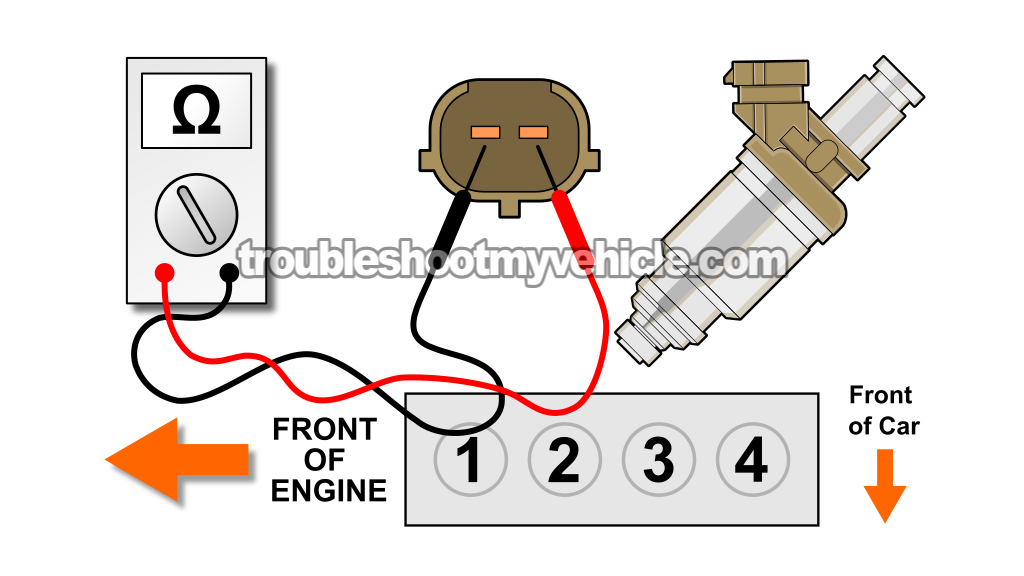
In this tutorial, I'm going to explain how to do a simple resistance test on the fuel injectors to find out if they have suffered an internal electrical problem.
Although fuel injectors are pretty hardy components that last a long time, sooner or later they are going to fail. So if you're suspecting you've got a bad fuel injector on your Corolla, this resistance test may confirm that the fuel injectors bad or that internally, it's good.
On top of that, I'm gonna give you a step-by-step diagnostic guide. If you're not sure where to begin, this guide will help you track down the faulty or clogged injector.
Contents of this tutorial:
APPLIES TO: This tutorial applies to the following vehicles:
- 1.8L (7A-FE) Toyota Corolla: 1993, 1994, 1995, 1996, 1997.
- 1.8L (7A-FE) Geo Prizm: 1993, 1994, 1995, 1996, 1997.
Fuel Injector Circuit Wiring Diagrams:
- Fuel Injector Circuit Wiring Diagram (1993-1994 1.8L Toyota Corolla).
- Fuel Injector Circuit Wiring Diagram (1995 1.8L Toyota Corolla).
- Fuel Injector Circuit Wiring Diagram (1996-1997 1.8L Toyota Corolla).
Symptoms Of A Bad Fuel Injector
Fuel injectors can fail in two main ways:
- Clogged Injector: The injector still sprays fuel, but poor atomization disrupts combustion, leading to performance issues.
- Failed Injector Coil: The injector's internal coil develops an open-circuit (break in wiring) or a short-circuit (internal failure), preventing it from receiving power and injecting fuel. This results in a misfire.
Since your Corolla's 1.8L engine needs fuel, air, and spark to run properly, a failing injector can cause serious driveability problems.
A bad injector can lead to noticeable engine performance issues, including:
- Cylinder misfire: The engine skips or runs unevenly, triggering the check engine light (OBD II equipped).
- Cylinder misfire trouble codes (OBD II equipped): You may see one or more of the following:
- P0300: Random Cylinder Misfire.
- P0301: Cylinder #1 Misfire.
- P0302: Cylinder #2 Misfire.
- P0303: Cylinder #3 Misfire.
- P0304: Cylinder #4 Misfire.
- Rough idle: The engine shakes more than usual when stopped, running unevenly.
- Loss of power: Pressing the gas feels sluggish, and acceleration is weak.
- Hesitation: The engine stumbles or jerks when you accelerate, making driving unpredictable.
This tutorial focuses on testing the injector's internal coil to check for an open or short-circuit, which would stop fuel flow entirely.
If you suspect a clogged injector, don't worry —I'll also walk you through a simple diagnostic method that will help you figure it out.
Let's get started!
Checking The Injector's Internal Resistance

The cool thing about testing the injector's internal resistance on the 1993-1998 1.8L Toyota Corolla is that the injectors are easy to access —no need to remove any engine hard parts to reach their two male spade terminals for testing with a multimeter.
As we check each injector's resistance, your multimeter should confirm that it's between: 13.4 to 14.2 Ohms (with the engine cold).
If an injector's internal coil winding has an electrical problem, its resistance will be out of spec —and noticeably different from the others.
The steps below assume you're testing all four fuel injectors:
- 1
Disconnect each injector from its connector.
NOTE: Use the diagram above to match every injector with its cylinder number on Toyota's 1.8L engine. - 2
Set your multimeter to Ohms (Ω) mode.
- 3
Place the multimeter leads on the injector's two male spade terminals to check resistance (look at the image viewer if you need a reference).
NOTE: A Toyota 1.8L injector should show a resistance reading between 13.4 and 14.2 Ohms. - 4
Write down the resistance measurement for the injector you're checking.
Use the diagram above to see which cylinder the injector belongs to. - 5
Do the same for all the other injectors, repeating steps 1 through 4.
Here's what your multimeter results tell you:
CASE 1: Every injector's resistance falls within spec or stays close to the others. That means they're all in good shape —none have an internal short or an open-circuit.
Why? A faulty injector with an open-circuit or short would've shown a resistance way off from the rest. Since all four readings match up, injector failure isn't the issue.
CASE 2: One injector's resistance stands out as completely different. That's a dead giveaway —it's bad. You gotta swap it out.
How To Find The Bad Or Clogged Fuel Injector
Figuring out whether a clogged or bad fuel injector is causing the misfire (rough idle, engine miss) on your 1.8L Toyota Corolla (or 1.8L Geo Prizm) is actually a pretty straightforward process.
The following step-by-step troubleshooting guide has helped me nail down a faulty fuel injector (whether its clogged or bad) about 95% of the time. This has saved time, money, and the frustration of replacing parts that don't solve the issue. I think it'll help you too!
Alright, here's the exact process I use when diagnosing a bad fuel injector:
- Identify the 'dead' cylinder first.
- If your Corolla isn't OBD II equipped, do a cylinder balance test to find which cylinder is misfiring.
- This tutorial will help you with this test:
- On OBD II equipped (1996+) vehicles, the misfire diagnostic trouble code will pin-point the 'dead' cylinder.
- Make sure spark is reaching all cylinders.
- Use a spark tester to confirm each plug wire is delivering spark.
- Check if engine oil has leaked onto the spark plugs or boots.
- Pull out and inspect the spark plugs for cracks or carbon tracking —this step's important.
- Misfires can happen due to carbon tracks. Here's a real-world example:
- Carbon Tracks Are A Common Cause Of Ignition Misfires (via easyautodiagnostics.com).
- Need help checking the distributor cap and spark plug wires? This guide has you covered:
- Check engine compression.
- Once you've confirmed all cylinders are getting spark, test for low compression.
- Compression tests often get ignored, but they're key for diagnosing misfires and rough idling.
- Here's how to do it:
- Run a Noid light test.
- If everything else checks out, use a Noid light to see if the injector's getting activated.
- This test confirms whether the injector is actually receiving a signal.
- Want a step-by-step? Here's a good resource:
- How To Use A Noid Light And Where To Buy It (via easyautodiagnostics.com—not the most detailed, but it gets the point across).
- Swap the suspect injector with the one next to it.
- After confirming a specific cylinder isn't firing, check these:
- Ignition system's working fine.
- Compression's within normal range.
- Injector's resistance is good.
- If the injector might be clogged, switch it with its neighbor.
- If the misfire moves with the injector, you've found the culprit —it's either clogged or bad and needs cleaning or replacement.
- After confirming a specific cylinder isn't firing, check these:
Figuring out which injector is the one causing the engine performance issue (because it's clogged or bad) on your 1.8L Toyota Corolla (or 1.8L Geo Prizm) might feel overwhelming, but it's totally doable.
The trick is to find the 'dead' cylinder first. This step-by-step approach has saved me a ton of time, money and frustration, and I'm pretty sure it'll do the same for you!
More 1.8L Toyota Corolla Tutorials
There are several more ‘how to’ tutorials that I've written that are 1.8L Toyota Corolla specific, that may be of further help. You can find them here:
Here's a small sample of the tutorials you'll find in the index:
- TPS Idle Switch Multimeter Test (1993-1997 1.8L Toyota Corolla).
- How To Test The Throttle Position Sensor (1993-1997 1.8L Toyota Corolla).
- How To Do A Cylinder Balance Test (1993-1997 1.8L Toyota Corolla).
- How To Test For A Blown Head Gasket (1993-2008 1.8L Toyota Corolla).

If this info saved the day, buy me a beer!

